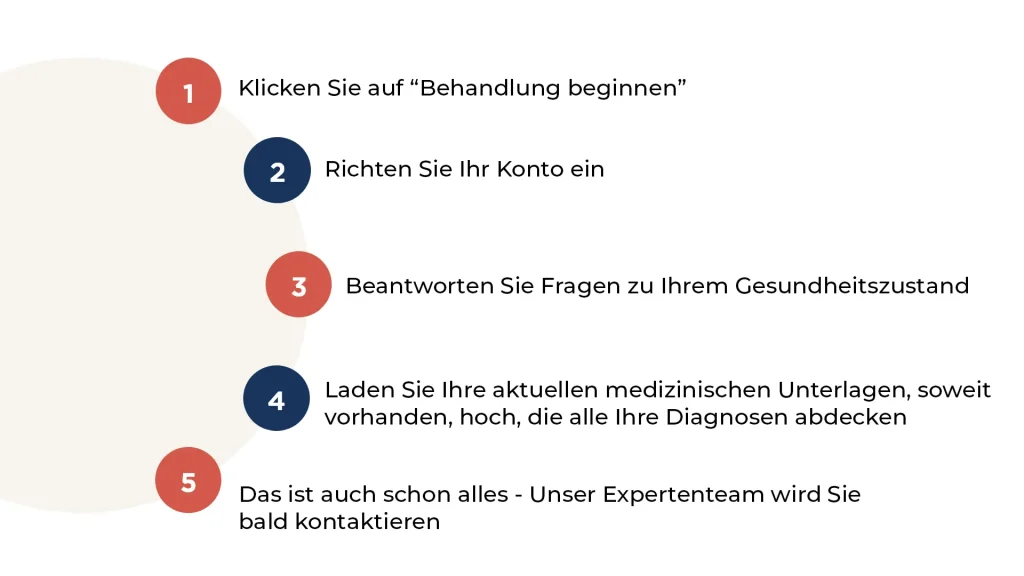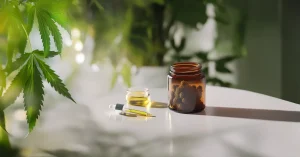Vorbereitung auf Ihre ärztliche Konsultation bei Canify clinics
Zunächst müssen Sie Ihr persönliches Patienten-Konto anlegen. Dort finden Sie Informationen zu Ihrem Profil und nützliche Hinweise. Sobald Ihre Anfrage geprüft und genehmigt wurde, können Sie Ihre Buchungen einsehen, verwalten und die Entwicklung Ihres Gesundheitszustands verfolgen.Hier sind ein paar generelle Empfehlungen für Sie als Cannabispatient, damit Sie sich auf Ihre Cannabis-Therapie vorbereiten können.

Konto einrichten
Zunächst müssen Sie Ihr persönliches Konto anlegen. Dort finden Sie Informationen zu Ihrem Profil und nützliche Hinweise. Sobald Ihre Anfrage geprüft und genehmigt wurde, können Sie Ihre Buchungen einsehen, verwalten und die Entwicklung Ihres Gesundheitszustands verfolgen.
Behandlungsanfrage für Cannabis Therapie ausfüllen
- Beantworten Sie anschließend bitte alle Fragen zu Ihrem Gesundheitszustand wahrheitsgemäß. Diese Informationen helfen dem behandelnden Arzt, Sie kennenzulernen und Ihnen eine optimale therapeutische Beratung anzubieten.
- Überlegen Sie, welche Symptomatik bei Ihnen mithilfe von medizinischem Cannabis vordergründig behandelt werden soll. Beispiele für Erkrankungen, bei denen Cannabis ärztlich verordnet werden kann, finden Sie unter Anwendungsmöglichkeiten. Bedenken Sie auch, ob bei Ihnen andere Diagnosen vorliegen, die Ihre Behandlung mit medizinischem Cannabis beeinflussen könnten.
- Bitte erstellen Sie einen Überblick über relevante Informationen zu den Medikamenten, die Sie aktuell wegen Ihrer Erkrankung einnehmen und in der Vergangenheit eingenommen haben (Name, Dosierung, Zeitraum). Der behandelnde Arzt benötigt diese Informationen, um sich gründlich in Ihre Krankengeschichte einzuarbeiten.
- Bitte tragen Sie die Dokumente zu Ihren Diagnosen soweit vorhanden zusammen. Ihre Patientenakte, Entlassungsberichte etc. können Sie von Ihrem Hausarzt, Ihrem Facharzt oder dem Krankenhaus anfordern. Beim Ausfüllen der Behandlungsanfrage werden Sie dazu aufgefordert, diese Dokumente hochzuladen.
Terminbuchung für Cannabis-Therapie in Ihrem Canify clinics-Konto
Sobald Sie als Patient angenommen wurden, können Sie in Ihrem Canify clinics-Konto Termine buchen, Ihre Buchungen verwalten und Videotermine wahrnehmen.
Vor Ihrem Termin
Haben Sie Beschwerden, die plötzlich auftreten und bei denen Sie sich rasche Linderung wünschen, oder benötigen Sie eine möglichst kontinuierlich wirkende Medikation? Die Darreichungsform des Cannabis hängt von Ihren Bedürfnissen ab und wird in Absprache mit dem behandelnden Arzt festgelegt. Machen Sie sich im Bereich Therapieoptionen mit den verschiedenen Darreichungsformen vertraut.
Cannabis-Therapie per Videosprechstunde
Für die Videosprechstunde sollten Sie sich an einem ruhigen Ort ohne potenzielle Störfaktoren in der Umgebung befinden. Der Arzt sollte Sie gut sehen können, wählen Sie also bitte einen Ort, der hell genug ist (z. B. tagsüber in der Nähe eines Fensters). Die Qualität der Konsultation erhöht sich, wenn Sie ein Gerät mit guter Kamera und einer schnellen Internetverbindung verwenden. Sie können während der Videosprechstunde gerne eine Begleitperson dabeihaben, falls Sie Unterstützung benötigen.
Nach Ihrem Termin
Wenn Sie Unterstützung dabei brauchen, die Konzentrationsangaben von THC und CBD auf Ihren Verschreibungen oder Produktetiketten richtig zu deuten, helfen Ihnen vielleicht die Informationen unter Praktische Hinweise weiter. Bitte beachten Sie aber in jedem Fall die Anweisungen des behandelnden Arztes und halten Sie sich im Zweifel immer daran.
Als Patient haben Sie gemeinsam mit Ihrem Arzt die Möglichkeit, auch zwischen den Terminen den Fortschritt Ihrer Behandlung anhand Ihres Gesundheitszustands zu verfolgen, um zu dokumentieren, wie sich die Therapie auf Ihr tägliches Leben, Ihre Leistungsfähigkeit und Ihr allgemeines Wohlbefinden auswirkt. Diese Informationen helfen Ihrem Arzt, sich auf Ihren nächsten Termin vorzubereiten und die Wirksamkeit Ihrer Behandlung einzuschätzen.
Häufig gestellte Fragen
Wie kann ich mich als Patient bei Canify Clinics registrieren?
Sie können sich einfach online registrieren und ein persönliches Patienten-Konto anlegen. Nach der Prüfung Ihrer Anfrage erhalten Sie Zugriff auf Ihr Profil, können Buchungen verwalten und Ihren Therapiefortschritt einsehen.
Welche Informationen werden bei der Behandlungsanfrage für die Cannabis-Therapie benötigt?
Bitte beantworten Sie alle Fragen zu Ihrem Gesundheitszustand ehrlich und vollständig. Dazu gehören Angaben zu Ihrer aktuellen Symptomatik, bisherigen Diagnosen, laufenden und früheren Medikamenten sowie relevante medizinische Unterlagen.
Warum ist es wichtig, alle medizinischen Unterlagen und Diagnosen bereitzustellen?
Ihre medizinischen Unterlagen geben dem behandelnden Arzt einen umfassenden Überblick über Ihre Krankengeschichte und ermöglichen eine individuell abgestimmte Therapie mit medizinischem Cannabis.
Welche Rolle spielen aktuelle und frühere Medikamente bei der Therapieplanung?
Informationen zu aktuellen und früheren Medikamenten helfen dem Arzt, Wechselwirkungen zu vermeiden und die Cannabis-Therapie optimal auf Ihre Bedürfnisse abzustimmen.
Wie buche ich einen Termin für meine Cannabis-Therapie bei Canify Clinics?
Nach Ihrer erfolgreichen Aufnahme als Patient können Sie in Ihrem Canify Clinics-Konto Termine buchen, verwalten und bei Bedarf Videotermine wahrnehmen.
Was muss ich vor einer Videosprechstunde beachten?
Suchen Sie sich einen ruhigen, gut beleuchteten Ort mit stabiler Internetverbindung. Nutzen Sie ein Gerät mit guter Kamera und vermeiden Sie Störquellen. Eine Begleitperson kann auf Wunsch anwesend sein.
Wie bereite ich mich optimal auf das ärztliche Gespräch vor?
Überlegen Sie im Vorfeld, welche Beschwerden Sie vorrangig behandeln lassen möchten. Halten Sie alle relevanten Diagnosen, Medikamentenlisten und Unterlagen bereit und informieren Sie sich über verschiedene Darreichungsformen von medizinischem Cannabis.
Welche Unterlagen sollte ich zum Arztgespräch bereithalten?
Bereiten Sie Ihre Patientenakte, Entlassungsberichte, Medikamentenlisten und gegebenenfalls aktuelle Befunde oder Labordaten vor. Diese können Sie auch vorab im Patienten-Konto hochladen.
Kann ich eine Begleitperson zur Videosprechstunde mitbringen?
Ja, Sie können eine Begleitperson zu Ihrer Videosprechstunde hinzuziehen, wenn Sie sich dabei wohler fühlen oder Unterstützung wünschen.
Was passiert nach meinem Termin bei Canify Clinics?
Nach Ihrem Termin erhalten Sie bei Bedarf ein Rezept für medizinisches Cannabis und können im Patienten-Konto Ihre weiteren Termine, Dokumente und den Therapieverlauf verwalten. Bei Fragen wenden Sie sich jederzeit an das Canify Clinics-Team.
Wie kann ich meinen Therapiefortschritt dokumentieren?
Im Patienten-Konto können Sie Angaben zu Ihrem Gesundheitszustand, zur Entwicklung der Symptome und zum Behandlungserfolg hinterlegen. Dies hilft Ihrem Arzt, die Therapie weiter zu optimieren.
Was bedeuten die THC- und CBD-Konzentrationen auf meinem Rezept?
Die Angaben zu THC- und CBD-Konzentrationen zeigen die Wirkstoffmenge in Ihrem Cannabis-Medikament. Details finden Sie in Ihrem Rezept oder auf dem Produktetikett. Im Zweifel fragen Sie Ihren Arzt oder nutzen Sie die praktischen Hinweise bei Canify Clinics.
Welche Darreichungsformen von medizinischem Cannabis gibt es?
Je nach Bedarf kommen Cannabisblüten (inhalativ) oder Extrakte (oral) zum Einsatz. Die Auswahl erfolgt individuell in Absprache mit Ihrem behandelnden Arzt.
Wie kann ich meine Termine und Behandlungsdokumente bei Canify Clinics verwalten?
Im Patienten-Konto haben Sie jederzeit Zugriff auf Ihre Termine, Dokumente und den Therapieverlauf. Dort können Sie Buchungen verwalten und Unterlagen hochladen.
Wie läuft die Kommunikation mit dem Arzt zwischen den Terminen ab?
Sie können Ihren Arzt bei Rückfragen über das Patienten-Konto kontaktieren und wichtige Informationen zu Ihrem Therapieverlauf bereitstellen. So ist eine kontinuierliche Betreuung gewährleistet.
Was sollte ich bei Unsicherheiten bezüglich Dosierung und Anwendung tun?
Wenden Sie sich bei Unsicherheiten immer an Ihren behandelnden Arzt und halten Sie sich strikt an dessen Anweisungen. Nutzen Sie ergänzend die praktischen Hinweise im Patienten-Konto.
Gibt es praktische Hinweise zur Einnahme von Cannabis-Medikamenten?
Ja, im Bereich „Praktische Hinweise“ von Canify Clinics finden Sie Informationen zur richtigen Anwendung, Dosierung und zu Besonderheiten der Cannabis-Therapie. Im Zweifel wenden Sie sich an Ihren Arzt.
Welche Vorteile bietet die Videosprechstunde für Cannabis-Patienten?
Sie sparen Anfahrtswege, erhalten schnelle Termine und können die ärztliche Beratung flexibel von zu Hause aus wahrnehmen – bei gleicher medizinischer Qualität und Datenschutz.
Muss ich meine Unterlagen vor jedem Termin neu einreichen?
Bereits hochgeladene Dokumente bleiben im System hinterlegt. Nur bei neuen Diagnosen oder Medikamentenlisten sollten Sie die Informationen aktualisieren und vor dem nächsten Termin ergänzen.
Wie kann ich mich auf die optimale Auswahl der Cannabis-Therapieform vorbereiten?
Informieren Sie sich im Vorfeld über die verschiedenen Darreichungsformen und überlegen Sie, welche Ziele Sie mit der Therapie verfolgen. Ihr Arzt berät Sie zur individuell besten Option.


